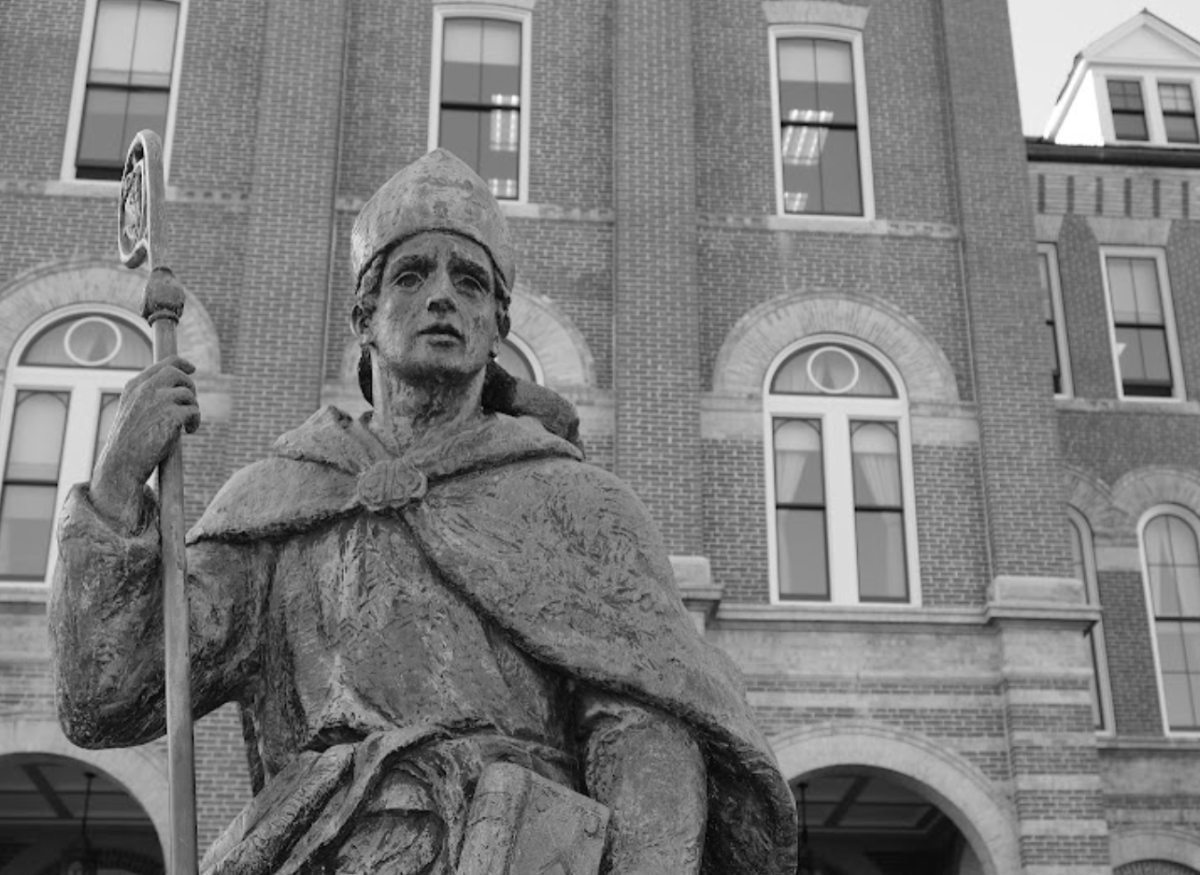A few weeks ago, I held a door open for a student heading into the Student Center, and he commented on how ‘Anselmian’ it was for me to do so. Maybe it was his sardonic tone, but the comment struck a nerve, and I started to think about what it is that makes something or someone an Anselmian. A dictionary is usually a good place to go to find out the meaning of a word, so I started there; Merriam-Webster defines ‘Anselmian’ as, “Of or relating to the scholastic philosopher Saint Anselm of Canterbury (1033-1109).” This literal sense may be too narrow for our college’s purposes, as few students (if any) actually meet the definition. Usually, the studies, not the students, are Anselmian. For example, it would be superficial to say that I am Anselmian by this narrow definition, even though Anselm’s Ontological Argument has been mentioned or studied in several philosophy courses I have taken.
If we wish to call our students and campus life Anselmian, the word’s meaning cannot be limited to the strict dictionary sense. However, we also cannot stray too far from it without its use either becoming meaningless or ironic. I do not wish to suggest that the second possibility, irony, has come about, as that would mean that our use of the word Anselmian directly opposes those values which Anselm himself ascribed to—I do not believe that we have fallen that far. Instead, I intend to argue that the former, meaninglessness, has already come about, evidenced by the way we toss about ‘Anselmian’ on campus.
The more meanings a word is made to include, the less exact it becomes; for example, the word ‘mammal’ refers to many more creatures than the word ‘dog,’ but it is far less informative because it does not specify what kind of mammal it is referring to (“I got a new pet mammal,” sed the precocious, pedantic child). In contrast, the word ‘dog’ includes all of the criteria for mammality and adds others, such as being domestic, carnivorous, possessing a long snout (usually), non-retractable claws, etc. To distinguish a dog from other mammals, like cats, we need to include such differentiating features (in Latin, differentiae) in the definition of dog. The popular use of the word Anselmian does not include such differentiae.
Typically, ‘Anselmian’ is used superficially in cases like my opening example—when students hold open doors for one another—or in others, like when students are active in clubs or Student Government. In these examples, we call one another Anselmian for politeness and social participation. Even if these are part of what it means to be Anselmian, they cannot sufficiently set apart our school from others- even if we somehow possess more courtesy and social cohesion than other schools (a claim of which I am sympathetic but not convinced). By the popular standard, a student at SNHU or Assumption could reasonably be called Anselmian for being polite. So, the question remains, “What sets us apart from other colleges?”
My immediate answer is our Catholic, Benedictine, liberal arts tradition, which unites us to the strict meaning of Anselmian by providing the foundation for a college culture based on those values which our patron professed. The Benedictines are the part of campus life that can most appropriately be called Anselmian in the literal sense; they follow the same monastic rule as Saint Anselm did a millennia before and have devoted their entire lives to the college in solemn vows.
However, the physical discipline and intellectual pursuits of the Benedictine order cannot be divorced from Christ. Any gym junkie or academic ascetic can set a routine and stick to it, schedule and willpower permitting. As was recognized at a recent Come Friday Forum on whether students’ lives should be more like monks’ lives, holding to the discipline of the Benedictine lifestyle without focusing on Christ is to live the life of a prisoner. The monks recognize this; each of them already lives in a ‘cell,’ for Christ’s sake (literally). The Benedictine Way is a pillar of our college community, which goes far deeper than our current identity. It ought to be seen as the model for a truly Anselmian culture.
Despite the college’s advertisement as a Catholic, Benedictine, liberal arts school, it is not at all rare to hear students complaining about the faith being ‘pushed down their throats,’ commenting how they are made uncomfortable by visual demonstrations of the Christian faith—like crucifixes in classrooms and monks in their black habits—and (most frequently) wondering why they have to take Conversatio and the core requirements, since, according to them, “they have nothing to do with my major.” Of course, many such comments come from incoming students’ general educational backgrounds (a problem with the American education system in general), and I refuse to believe that it is entirely the students’ fault. Call me naïve, but students who have taken an introductory course in the humanities and liberal arts ought to know at the very least what the humanities and liberal arts are, even if only vaguely, and be able to explain to some extent why they are valued, even if they disagree with the reasons. If anything, the failure reflects less on the students and more on the drastic need to reformulate the contents of our core curriculum and reconsider its purposes. This is an essay on Anselmian culture, but culture often extends to academics, and academics often influence culture. Administration has its hands in both.
Reviving a culture based on our tradition does not have to be an insurmountable obstacle for Saint Anselm College administration; we can look to other examples of Catholic colleges that have successfully maintained a strong Catholic identity while promoting a variety of cultures. Over Fall Break, I had the opportunity to fly out to Atchinson, Kansas, to visit a friend at Benedictine College, which is on the Newman Guide. This source recognizes authentically Catholic colleges. Amidst the cornfields, I found a campus that reversed the statistic of students who lose their faith when they go to college. Instead of about two-thirds of students leaving the faith after four years, Benedictine boasts that over two-thirds report an increase in faith by graduation. I would love to be wrong, but I doubt Saint A’s can say the same. The campus’s grounding in faith is something that our administration ought to be fighting for, out of love not only for the students but for the love of Christ.
With that being said, I must profess my love for the character of the Hilltop. Although Benedictine College may share its mission with Saint A’s, and fulfills it more thoroughly, it does not have that same character that I have grown to know and love in my time here. At Saint A’s, we take pride in our diversity of culture and character in the student body. Our student experience is unique, even among those few colleges with which we share the mission of the Catholic, Benedictine, liberal arts tradition.
Since we share our tradition with a few other colleges, the question still remains about what sets us apart from them. Of course, geographical considerations may be considered, as our culture has grown on New England soil. At the very least, this influences our student and faculty demographics and thus loosely affects campus life. But this is not a factor upon which we can base a persistent college identity (the demographic makeup of SAC has changed and will again change). The true defining feature of our college, which sets it apart from the rest, is its proper name, chosen by our Benedictine founders and not shared with any other American university. Our spiritual and academic tradition follows from the life and faith of Saint Anselm. He has been dedicated as our guide and intercessor in the pursuit of truth through the synthesis of faith and reason, so aptly characterized by our largely abandoned motto, Initium Sapientiae Timor Domini: Fear of the Lord is the beginning of Wisdom (Proverbs 9:10). If we have such clear foundations, what is stopping the college from fulfilling the mission it professes?
It does not take superhuman perception to see what is stopping the college. There seems to exist a fear among some that any attempt to lean into our Catholicity would make students uncomfortable. This belief that discomfort is an evil is often euphemistically described as an emphasis on “Benedictine hospitality.” I believe, however, that this fear keeps the college from being more deeply Catholic, more authentically Anselmian, and that it leads to the loss of faith among new students who arrive without a solid Catholic foundation. Without a Catholic culture, students are beleaguered by the overwhelming cultures of our world with no weapons to resist. Reviving a Catholic culture does not necessarily mean that other cultures will be destroyed. The word Catholic comes from the Greek word ‘katholikos,’ meaning ‘universal.’ The universality of the Catholic mission not only applies to our mission to love all people, but also to extend the faith to all people—this cannot be done if we are passive rather than active in our mission.
The greatness of Christianity comes not only from its ardent love of all but also from its ferocious hatred of evil. As Chesterton wrote in Orthodoxy, “We do not want joy and anger to neutralize each other and produce a surly contentment; we want a fiercer delight and a fiercer discontent.” We must strive to love all people as Christ did, but we cannot be content with all practices, especially when they are present on our campus. Even Jesus flipped tables in the temple of Jerusalem (Matthew 21:12, Mark 11:15) and proclaimed that he came to “set the world on fire.” (Luke 12:49)
As far as I’m concerned, there aren’t many tables that need flipping at SAC, few glaring issues that plague the everyday day of the average student, but the ones we face are substantial because they are cultural and, therefore, both pervasive and subversive. Our problem is not that we- both students and administration- do not see the tables, but we lack the leaders necessary to flip them. We need figures who will recognize the college’s cultural and administrative failings and work to solve them out of ardent love for the college and the community it supports.
Students are the main participants in campus culture and are often cocreators of that culture, but cultural reform cannot fall entirely into student hands because the entire student politic changes every four years; one class may bring about some minor cultural or institutional changes, but those changes may be quickly reversed by the time the next few classes are admitted onto campus. Not only is there not enough of a persistent identity in the student body, but we simply do not possess as students the necessary institutional foundations to bring about substantial changes, as evidenced by failures in student government, whether ineffective bills or general stagnation. To reclaim what it means to be Anselmian, the administration must work with and for students to push for a cultural return to our deep roots, both spiritual and academic, in the Catholic, Benedictine, liberal arts tradition under the protection and guidance of our intercessor and namesake.



